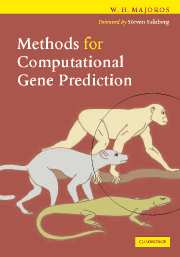Book contents
- Frontmatter
- Contents
- Foreword by Steven Salzberg
- Preface
- Acknowledgements
- 1 Introduction
- 2 Mathematical preliminaries
- 3 Overview of computational gene prediction
- 4 Gene finder evaluation
- 5 A toy exon finder
- 6 Hidden Markov models
- 7 Signal and content sensors
- 8 Generalized hidden Markov models
- 9 Comparative gene finding
- 10 Machine-learning methods
- 11 Tips and tricks
- 12 Advanced topics
- Appendix
- References
- Index
1 - Introduction
Published online by Cambridge University Press: 05 June 2012
- Frontmatter
- Contents
- Foreword by Steven Salzberg
- Preface
- Acknowledgements
- 1 Introduction
- 2 Mathematical preliminaries
- 3 Overview of computational gene prediction
- 4 Gene finder evaluation
- 5 A toy exon finder
- 6 Hidden Markov models
- 7 Signal and content sensors
- 8 Generalized hidden Markov models
- 9 Comparative gene finding
- 10 Machine-learning methods
- 11 Tips and tricks
- 12 Advanced topics
- Appendix
- References
- Index
Summary
The problem that we wish to address in this book is that of predicting computationally the one-dimensional structure of eukaryotic protein-coding genes. Our first order of business will be to define this problem more precisely, and to circumscribe the issue so as to reflect the set of assumptions and constraints which typically apply in the case of practical gene-finding systems. As we recognize that not all readers will be familiar with the relevant facts and theories from molecular biology, we begin with the so-called central dogma of molecular biology, in which the significance of genes and their genomic structure are defined in relation to current biological understanding and the goals of modern medicine.
The central dogma of molecular biology
Life on Earth began approximately 3.5 billion years ago, and since that time it has advanced through a number of stages of increasing complexity. Beginning with the first replicating molecules and unicellular organisms, our own evolutionary trajectory has taken us along an epic journey progressing from microscopic invertebrates to bony fishes, to the amphibians and reptiles who first established the vertebrate kingdom on dry land, to the basal mammals who hid from the dinosaurs among the primitive trees and bushes of the Mesozoic era, and then on to our closest living relatives, the great apes. Through all that time, one fact has remained constant: that our animal selves, both physically and cognitively (with the latter following, of course, the advent of that organ which we call the brain) have been extensively shaped by the action of our genes, through their influence both on our bodily development (our ontogeny) and also on our ongoing biological processes, both of which are overwhelmingly mediated through the action of proteins, the primarily biochemical products of gene expression.
- Type
- Chapter
- Information
- Methods for Computational Gene Prediction , pp. 1 - 27Publisher: Cambridge University PressPrint publication year: 2007



